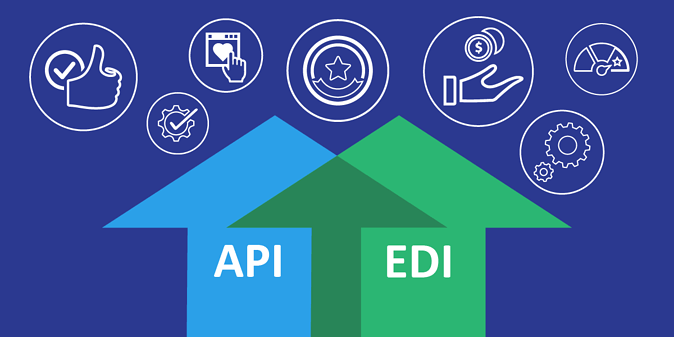While the world is gradually shifting to a new normal, organizations haven’t traded pandemic uncertainty for confidence just yet. Shortages and delays in the global supply chain have impacted COVID recovery and will continue to affect the economy for the foreseeable future.
With limited access to resources and raw materials, increased labor shortages, and rapidly growing business costs due to inflation and other factors, businesses continue to face numerous challenges.
More than ever, organizations need better collaboration with supply chain partners to serve their customers and meet business goals.
Modern integration capabilities (such as APIs) combined with tried-and-true Electronic Data Interchange (EDI) solutions can help businesses manage costs, maximize margins, minimize disruptions, accelerate business velocity, and identify areas where they can realize a competitive advantage, even during difficult times.
Let’s explore how a combined EDI and API integration approach can contribute.
Why APIs and EDI Together are Critical for Supply Chain Data Movement
Communication Delays Impact All Partners in the Supply Chain
For decades, EDI has worked well for large “hub” companies with their suppliers. However, with EDI, communication is still batched, the response time can be slow, and visibility into processes and transactions lags.
As organizations add a growing volume and variety of supply chain partners and exchange data more often, the limitations of EDI are evident. For example:
Manufacturers lack oversight into production needs and face delays.
When EDI systems are disjointed and individualized, it’s difficult for manufacturers to forecast how much of a product to make, when, and for whom. As trading partner communities grow—better connected, more real-time integration is needed to get sufficient visibility.
Freight carriers can’t optimize their shipments in time.
Freight carriers need real-time shipment status updates to estimate per-trip revenues and maximize carriage space. Delays in communication can be problematic.
Retailers need greater, real-time visibility into their stock.
When transactions aren’t in real-time, retailers struggle to stay on top of inventory availability, stockouts and overstock. It impedes their ability to coordinate inventory as it’s purchased in real-time outside of stores.
Adding Real-Time APIs Helps to Fill in the Gaps
The fast pace of digital transformation that occurred during the pandemic has helped make business communication more efficient. Along with this, expectations for real-time communication and collaboration in all areas of business have continued to escalate. This has accelerated the initiatives around combining Application Programming Interfaces (APIs) and EDI.
APIs can complement and add to EDI functionality. They’re cloud-ready connections crafted with more flexibility than protocol-bound EDI. Leveraging APIs, systems can transfer information many times a day and get responses immediately. APIs can be a better fit for sending tracking time-sensitive data, quotes, or other data that requires immediate, real-time attention.
However, many companies lack the resources or know-how to build, manage, and support both EDI and API connections. That’s where a modern EDI Cloud and/or SaaS solution – and partner like us -come in.
Cloud and SaaS EDI Solutions Can Improve Supply Chain Collaboration
To optimize their supply chains and get the most out of their software investments, organizations can leverage cloud EDI or SaaS EDI integration solutions with an experienced provider that can help deploy and manage EDI and APIs together.
The Best of Both Worlds
EDI
- Moves vast amounts of data securely and reliably
- Uses proven technology that’s been the backbone of the industry for decades
APIs
- Simple, widespread connectivity for new partners
- Fast setup and low-cost
- Easy to manage and maintain
Maximize Efficiency and Conserve Resources with Cloud-Based Solutions
The process of building, managing, and maintaining integration software is a technical undertaking that few organizations have the in-house expertise or bandwidth to handle.
Cloud or SaaS solutions make integrated EDI and API solutions accessible for any business. They can reap the benefits of state-of-the-art software without worrying about setup, maintenance, and ongoing management. This enables companies to use their resources more efficiently in a rapidly scaling B2B network environment.
With a SaaS approach to modern B2B data exchange, organizations benefit from:
- Rapid deployment
- Automatic, managed updates and upgrades without hassle
- Predictable costs
- Heightened security and availability
Automate B2B Transactions in the Cloud
Digital business networks based in the cloud—such as the IBM Sterling Supply Chain Business Network—utilize both EDI and API capabilities to streamline business communication and make data available on demand. And that flexibility comes with advantages, including:
- Less lag time for faster responses
- Accelerated collaboration with supply partners
- Greater visibility for better depth and scope of business intelligence to make better, more agile decisions
- Integrated data and applications with enhanced features
- Coordinated EDI and API transactions in a hybrid environment, enabling the use of EDI and APIs as needed
Using EDI and APIs together enhances customer satisfaction and streamlines collaboration between partners and internal users. Communication and response times are faster and more agile. Together, EDI and API help to improve visibility and responsiveness.
Business Value of EDI/API Integrated Solutions for B2B Supply Chain Partners
- 335% three-year ROI
- 50% reduced late orders
- 51% more efficient transactions
- 77% improved IT support
- 41% faster partner onboarding
Build a Smarter Supply Chain with Eliassen Group
Combining EDI and APIs is essential to modern businesses, and the right EDI SaaS solution can lead to better communication within your supply chain to encourage growth—even during a time plagued with post-pandemic supply, staffing, and inflation issues.
We help companies leverage the IBM Sterling Supply Chain Business Network to deliver frictionless connectivity between supply chain partners through a unified EDI/API system. With the ability to reliably communicate real-time data on-demand, supply chain partners can lower operational overhead, save time and money, and ultimately find new ways to grow.



